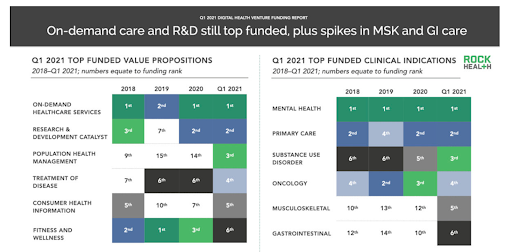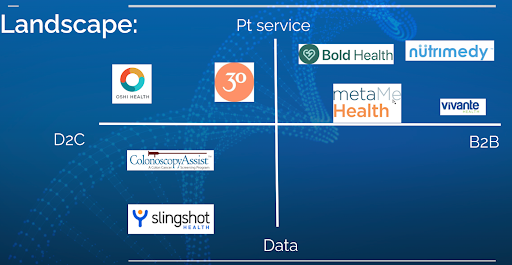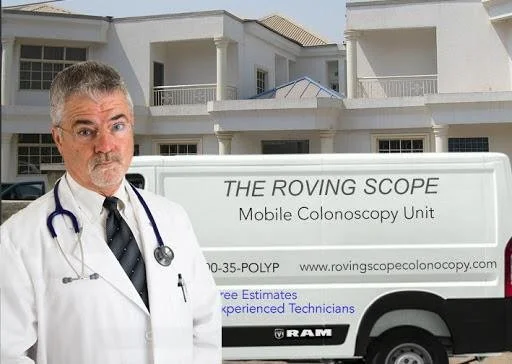GI = gastro/gastroenterology/guts/gastrointestinal/got it?
Source: Rock Health
👀 GI is getting sexier for investors 👀
Investors are interested in the GI space, and this love affair started recently. GI moved from the 12th most funded speciality back in 2018 to the 6th most funded speciality in 2021. This makes sense as primary care companies have matured and investors, entrepreneurs, and companies are now looking into different markets.
GI TECH LANDSCAPE
Pt = patient
D2C = direct-to-consumer
B2B = business-to-business
I created this graphic to show some companies are interested in the D2C space on the left side and some only work with other businesses (usually employers or payors) on the right. This is certainly not comprehensive as the landscape is rapidly expanding, evolving, and changing.
Starting at the top left:
Oshi Health provides a patient service and, at the moment, is D2C. It's a complete telemedicine service for GI conditions providing a virtual GI doc, health coach and psychologist.
The number 30 represents 30 Madison, a company in a similar space as Ro and Hims/Hers. They have an on-demand platform to link reflux sufferers to a provider and the platform can then deliver generic heartburn medications to their doorstep. They expanded to include delivering probiotics, fiber, and magnesium.
Top right:
There’s Bold Health out of London. Another telemedicine platform with a virtual GI doc, dietitians and psychologist available, and integrates digital therapeutics for IBS, IBD, and abdominal pain. Digital therapeutic is a software app that treats a specific condition. This could be stand alone or paired with medication. Pear Therapeutics also has a GI product in their pipeline.
metaME Health is also in the digital therapeutic space, specifically for IBS-associated abdominal pain. One of their products is FDA cleared as of 11/2021, according to their website.
Nutrimedy is a digital nutritional companion offering evidence-based and personalized clinical nutrition support across multiple medical conditions. The company has a gastroenterologist founder.
Vivante Health - All-in-one platform for employees with GI conditions. Sound familiar? Livongo did this for diabetes.
The bottom left:
ColonoscopyAssist - This website allows you to schedule an upper endoscopy or colonoscopy nationwide and provides the all-in price, leading the way in price transparency. Last I checked, a Manhattan surgical center was offering an endoscopy or colonoscopy for $1,075. It also has information on the performing gastroenterologist (active state license, how many years of experience, average endoscopies performed per month). And, it provides info on the facility where the procedure will be performed (accreditation, how many rooms and how many procedures are done per month).
Slingshot Health allows a patient to name their price for a procedure and a doctor in their area can accept or counter. Again, these companies avoid the problem of surprise billing. Slingshot is a peer-to-peer auction where true price discovery happens.
Did this conjure up this memory?
What about the bottom quadrant? Who’s in the B2B data space? ALL companies, potentially. Health data is valuable to many different players.
What’s to come in 2022:
Further Consolidation of GI practice groups continues – a dominant GI-specific app will be born. A tech solution emerges to help with appointment reminders, prep questions and overall clinical workflow. All of it. Not in piecemeal fashion.
More niche GI digital health companies bloom - personalized care services blending genomics, microbiome, and lifestyle data to allow self-management and connection to virtual care when needed
Poop is good for business. Taking pictures of it. Analyzing it. We are only at the onset of understanding what the gut microbiome does and how it impacts our lives.
New care models are born: Having a colonoscopy is a giant pain in the…
I joke that one day we will soon be able to perform a colonoscopy in a Starbucks parking lot. Ok, maybe not a colonoscopy. However, how about seeing your gastroenterologist in a nearby parking lot?
*The Roving Scope is not a real company…yet



